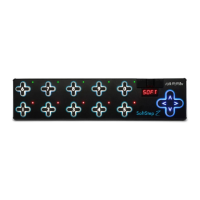SSCOM Port 1 in Hosted Mode
When operating in Hosted mode, SSCOM Port 1 behaves differently than it does in Standalone
mode.
In Hosted mode, SSCOM Port 1 transmits the SoftStep’s raw sensor data to the editor, which then
processes the data into the correct MIDI messages and outputs it.
Note: The SoftStep’s raw data appears as a series of MIDI CC messages —!CCs 40-83 (four per key,
including the Nav Pad). If “weird” CC messages appear when using the SoftStep in Hosted mode, SSCOM Port
1 will need to be disabled or Þltered out in the software being used. Some applications allow for this (Ableton
Live, Traktor, or Max/MSP, for example) while others do not and are just listening to all MIDI ports at all times
(Logic and MainStage, for example). The latter can be quite tricky when trying to MIDI map.
SoftStep Share
SoftStep Share is a virtual MIDI port provided with the Mac OS version of the Advanced Editor. It is
used as an inter-application MIDI bus —!it routes MIDI from the editor to other applications.
SoftStep Share is only available (and only necessary) when in Hosted mode —!audio/MIDI
applications should listen to this port to receive MIDI (when in Hosted mode).
Using SoftStep Share is simple —!it is automatically available after opening the Advanced Editor,
and using it is just a matter of selecting “SoftStep Share” as the Output Port of the modlines.
Windows Users
The Windows version of the Advanced Editor does not come with a built-in virtual MIDI port
—!users will have to download and install a third-party MIDI bus of their choice.
KMI recommends using MIDI Yoke (http://www.midiox.com/myoke.htm) or LoopBe (http://
www.nerds.de/en/loopbe1.html). Once installed, “Out to MIDI Yoke: [1-8]” or
“LoopBe” (depending on which one was installed) will automatically appear in the Output Port
drop-down in the modlines.
Note: It may look like MIDI Yoke is out of date, but it will still install and run just Þne on computers
running Windows 7 and Windows 8. Be aware that the UAC (User Account Control) will likely need to be
disabled for the installation to work.
Advanced Editor 52
ホステッド・モードにおける SSCOM ポート 1 の動作
ホステッド・モードの場合、SSCOM ポート 1 の動作はスタンドアローン・モードの時とは異なり
ます。ホステッド・モードでは、SSCOM ポート 1 は SoftStep の生のセンサー・データをエディタ
に送信し、エディタがこのデータを正しい MIDI メッセージに変換して出力します。
参考:SoftStep の生データは、一連の MIDICC メッセージ――CC40 〜 83(ナブ・パッドを含むキー 1 個
あたり 4 個)――のように見えます。SoftStep をホステッド・モードで使用中に “奇妙な” CC メッセージが
現れた場合には、SSCOM ポート 1 をオフにするか、あるいは使用するソフトウェアでこれらのメッセージを
フィルターで除去する必用があります。そのための機能を持ったアプリケーション(AbletonLive や Traktor、
Max/MSP など)もありますが、持たないアプリケーション(Logic や MainStage など)は全ての MIDI ポート
の信号に常に反応してしまうので、MIDI マップを行うのが難しい場合があります。
SoftStepShare
SoftStepShare は、MacOS 版のアドバンスト・エディタに組み込まれた仮想 MIDI ポートです。
これはアプリケーション同士をつなぐ MIDI バスとして、エディタから他のアプリケーションに MIDI
信号を分配するのに使用します。
SoftStepShare は、ホステッド・モードでのみ使用できます(この場合にしか必要ありません)。
オーディオや MIDI のアプリケーションは、(ホステッド・モード時には)このポートから信号を受信
する必要があります。
SoftStepShare の使い方は簡単で、アドバンスト・エディタを起動し、モッドラインの出力ポートで
“SoftStepShare” を選択するだけで利用可能になります。
Windows ユーザーの方へ
Windows 版のアドバンスト・エディタには、仮想 MIDI ポートが組み込まれていません。ユーザーの方が
各自でサードパーティの MIDI バスをダウンロードしてインストールする必要があります。
KMI 社では、MIDIYoke(http://www.midiox.com/myoke.htm)
または LoopBe(http://www.nerds.de/en/loopbe1.html)を推奨しています。インストールすると、
“OuttoMIDIYoke:[1-8]” または “LoopBe”(インストールした MIDI バスによります)というオプションが、
出力ポートのモッドラインのドロップダウン・メニュー内に現れます。
△参考:MIDIYoke は古いアプリケーションのように見えますが、Windows7 および 8 上でのインストール
にも動作にも問題ありません。ただし、インストールの際には UAC(ユーザー・アカウント・コントロー
ル)をオフにする必要があるかもしれません。

